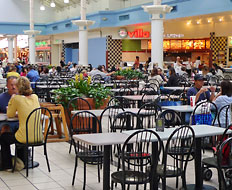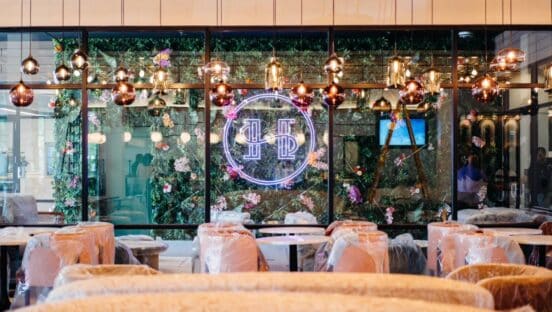Ever since the first farmers packed up their produce to sell in the town square, food has been an important part of the shopping experience. But lately, it seems the food is better than ever.
At the Macy’s in Chicago, celebrity chefs like Rick Bayless have set up shop with their own quick-service or fast-casual restaurants. In London, luxury department store Harrods boasts 30 restaurants ranging from casual to opulent. And these aren’t the only places beefing up their food offerings.
Shopping centers across the country are investing, turning to food as a way to lure guests back.
Les Morris, spokesman for major mall owner Simon Property Group, says that the best way to a customer’s heart is through his stomach.
“The role of food in a mall is important and will continue to be,” Morris says. “Mall food-hall offerings will only continue to evolve.”
Evolution is a matter of survival of the fittest, and the food court business is no exception. While mall industry representatives insist their industry is booming, those closer to the business tell a different story.
California-based Hot Dog on a Stick has 102 mall locations out of a 104-store system, and executive vice president Laurie Sonia is keenly aware that traffic is down.
“Malls in the last few years have changed dramatically because of the economy, and also because online shopping has become so easy,” Sonia says. “I honestly don’t think the demographics have changed, I just think there’s less people going to malls.”
Those changes have had real impact on mall tenants. Dippin’ Dots, a longtime mall favorite, recently filed for bankruptcy, and Hot Dog on a Stick saw its sales fall in 2009 and 2010. Sonia says the percentage her sales fell was more or less the same percentage total mall traffic fell.
“The last two years before this one our sales had decreased, anywhere between 5 and 10 percent [a year],” Sonia says. “I think that’s why you’ve seen so many retailers go out of business—it’s hard to sustain those kind of losses.”
While the newspapers have backed off from the doom-and-gloom predictions they made in 2009 (the Wall Street Journal talked about “ghost towns” then), the mall situation is still far from rosy.
An October 23 article in USA Today quotes a study by Commercial real estate research firm Reis that shows mall vacancies at an 11-year high in the third quarter of 2011.
With big retailers like Border, Blockbuster, and Linens N’ Things shut down and hundreds of other stores closing, mall owners are turning to other things to attract traffic.
“Coming out of the recession, there’s been an increase in importance in dining and entertainment,” International Council of Shopping Centers spokesman Jesse Tron says. “Basically right now the focus is redevelopment.”
Tron says the general plan is to give customers more reasons to come into the mall. Since eating at a restaurant is a fundamentally social activity, bringing in more eating options encourages people to come and bring their friends.
Suzyn Cragin, manager of Superior, Wisconsin’s Mariner Mall, says her mall’s two restaurants have been helpful in boosting traffic.
“Both of them draw people,” Cragin says. “When people are shopping they need places to dine. [It] makes people stay a little bit longer and shop a little bit longer.”
Tron says as businesses emerge from the recession, the emphasis has been on more traditional restaurants, which have a larger footprint and provide more of a destination feel to a mall.
“Outside of the food court is where you’re seeing those changes,” Tron says. “Those larger chain-style restaurants are pretty popular, as well as coffeeshop/cafes.”
This increased emphasis on sit-down dining means more competition for quick serves.
Tron says, however, that food courts are changing as well. An attractive central eating space serves as a gathering point, and malls have been quick to jump in and make them as comfortable and eye-catching as possible.
Part of the spirit of providing more options means developing and expanding quick serves along with sit-down restaurants.
“You have certain consumers who want to come in and grab a quick bite,” Tron says. “[The] food court’s still certainly integral.”
Even when the tenant mix doesn’t change, the ambiance does.
Fixtures, carpeting, and lighting can freshen up a food court, especially when more expensive materials are used.
Sonia notices this trend in some of the malls where Hot Dog on a Stick has a presence.
“They are getting more upscale,” Sonia says. “I think in general they’re trying to take it in a more upscale direction.”
One mall that has invested significant money into its food court is San Diego’s Fashion Valley. As part of the first phase of the multimillion-dollar renovation project, the mall updated and modernized the food court space. It added contemporary tables and chairs, along with banquette and bar seating that increased the total seating by about 10 percent. Vertical landscaping, large ceramic potted plants, skylights streaming natural light, and freshly repainted surfaces made the food court inviting. Morris says it’s all about getting guests to linger.
[pagebreak]
“The more uses people can get from coming to our malls, the more touches they have with the property, the better it is,” Morris says. “Our trade group said the average visit to a shopping center was 82 minutes. If we can extend that somehow, that’s great.”
Another planned development is in Indianapolis’s Fashion Mall at Keystone. It’ll have a newly renovated food hall by the 2012 holidays, complete with an impressive mix of tenants.
Morris says that while it’s too early in the game to say exactly who’s coming on board, the new food hall will be worth waiting for.
“We’re looking to bring in unique local and national concepts to the food hall, some of which will be new to Indianapolis,” Morris says. “We’re looking to create a destination.”
Some concepts aren’t waiting for the mall to do the legwork, choosing instead to become a destination on their own.
Several high-end chefs have played off of their celebrity appeal to stand out in a crowded marketplace.
Frontera Fresco, which is owned by celebrity chef Rick Bayless, provides a fast-casual spin on Mexican favorites. With hot Mexican sandwiches and tacos, homemade salsa, and Mexican craft beer, the restaurant has become a popular stop at the Macy’s in Chicago.
Wolfgang Puck Express is even more widespread, with locations in airports and malls around the country. With smoked salmon pizza, Chinois chicken salad, and other modern California dishes, the restaurant appeals to people looking to get a fine-dining experience when they’re pressed for time.
These concepts are gaining fans beyond the mall crowd—in fact, Travel and Leisure Magazine named both of them among the World’s Top Fast Food Restaurants.
While more upscale brands draw their fair share of guests, Sonia says she hasn’t noticed a trend.
“I haven’t noticed a big difference except for a little bit of a local feel,” Sonia says. “I think the same national brands are in those food courts.”
There are several approaches the national brands take to stay relevant.
Sarku Japan, an Asian chain focusing on teriyaki and sushi, has 200 locations predominately located in food courts. Its able to stand out in a crowd by offering food that is both healthy and exotic.
But Cinnabon, another mall court favorite, is nearly the opposite, positioning itself as both indulgent and familiar. The trick lies in understanding what makes mall shoppers tick. Cinnabon has had great success by leveraging the sense of smell. In an enclosed environment, the smell of warm cinnamon can draw diners who might not have thought twice about stopping if they had simply seen a sign.
Another popular mall technique? Free samples, a la Baskin-Robbins. David Kincheloe, the President of National Restaurant Consultants, says this is a time-tested mall strategy.
“You walk through a food court and the Japanese place always has chicken teriyaki on a toothpick,” Kincheloe says. “You can do the same thing. Someone’s trying to make a decision, you stick a piece of food in their mouth they like, you help them make their decision.”
Doc Popcorn is one chain that’s been able to tap into mall shopper psychology. The company uses enticing smells to draw diners in, a clear view of the popping process to get them interested, and free samples to get them hooked. By letting kids have samples and offering mom the option of sharing a bag, operators practically guarantee a sale.
“We make sure mom gets exactly what she wants,” founder Rob Israel says. “We get the kids cups if she only wants to buy one bag. We didn’t just give away a little bit of popcorn—we saved mom’s day.”
Another strategic concern is presentation. Kincheloe says he’s been able to get clients a 3-5% check boost simply by subtly emphasizing freshness. The trick is to use props, like prominently displayed produce, strung-up sausages, or wheels of cheese. This display gives a “deli” feel to a food court location and has a way of catching the eye.
“If you have some kind of a bread product, you could make yourself look fresh by having bread for props,” Kincheloe says. “If you’re offering chips, make sure you overstuff it. We did a test out and popped the check average just by giving them that fresh look.”
Of course, as any realtor could tell you, location is key. Since Doc Popcorn is a snack instead of a meal, franchises try to find places away from the main food court. Israel has given significant thought to other elements of placement as well.
“People want to be in natural light,” Israel says. “I think it lends nicely to the way the product is presented. But if you’re in direct sunlight all day, your staff will blow up. We like open ceilings as opposed to overhangs, because you can be viewed from above. Ideally you’re near some draws for families. A decision point is nice, when folks have to pause that’s good for an impulse purchase as well.”
At some malls, location can mean the difference between success and failure. At others, there are so many customers flowing through that a slightly less popular corridor isn’t a make-or-break situation. Israel says the best option is to scout the mall ahead of time and be willing to negotiate.
“It’s not a disadvantage to be in a mall at all,” Israel says. “The challenge is finding good locations and paying the right rent. Those are negotiations that just take place. We’ve built quite a reputation now in the mall, and we’re able to get reasonable rents and good locations.”
While recent years have seen a shift in spending patterns, the mall isn’t going away any time soon. And as long as there are malls, there will be food courts. Dining helps make a mall what it is—a community gathering place, rather than simply a collection of stores.
“The regional mall is still the best option for the delivery of goods and services,” Morris says. “[And] it’s really important to have good food.”






